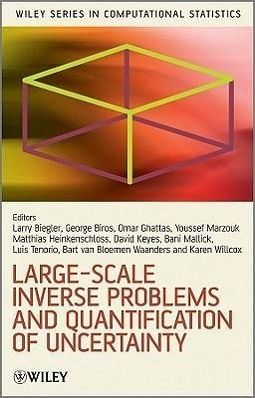
Large-Scale Inverse Problems and Quantification of Uncertainty
Versandkostenfrei!
Versandfertig in über 4 Wochen
157,99 €
inkl. MwSt.
Weitere Ausgaben:

PAYBACK Punkte
79 °P sammeln!
This book focuses on computational methods for large-scalestatistical inverse problems and provides an introduction tostatistical Bayesian and frequentist methodologies. Recent researchadvances for approximation methods are discussed, along with Kalmanfiltering methods and optimization-based approaches to solvinginverse problems. The aim is to cross-fertilize the perspectives ofresearchers in the areas of data assimilation, statistics,large-scale optimization, applied and computational mathematics,high performance computing, and cutting-edge applications.The solution to large-scale inverse pro...
This book focuses on computational methods for large-scalestatistical inverse problems and provides an introduction tostatistical Bayesian and frequentist methodologies. Recent researchadvances for approximation methods are discussed, along with Kalmanfiltering methods and optimization-based approaches to solvinginverse problems. The aim is to cross-fertilize the perspectives ofresearchers in the areas of data assimilation, statistics,large-scale optimization, applied and computational mathematics,high performance computing, and cutting-edge applications.
The solution to large-scale inverse problems critically dependson methods to reduce computational cost. Recent research approachestackle this challenge in a variety of different ways. Many of thecomputational frameworks highlighted in this book build uponstate-of-the-art methods for simulation of the forward problem,such as, fast Partial Differential Equation (PDE) solvers,reduced-order models and emulators of the forward problem,stochastic spectral approximations, and ensemble-basedapproximations, as well as exploiting the machinery for large-scaledeterministic optimization through adjoint and other sensitivityanalysis methods.
Key Features:
* Brings together the perspectives of researchers in areasof inverse problems and data assimilation.
* Assesses the current state-of-the-art and identify needsand opportunities for future research.
* Focuses on the computational methods used to analyze andsimulate inverse problems.
* Written by leading experts of inverse problems anduncertainty quantification.
Graduate students and researchers working in statistics,mathematics and engineering will benefit from this book.
The solution to large-scale inverse problems critically dependson methods to reduce computational cost. Recent research approachestackle this challenge in a variety of different ways. Many of thecomputational frameworks highlighted in this book build uponstate-of-the-art methods for simulation of the forward problem,such as, fast Partial Differential Equation (PDE) solvers,reduced-order models and emulators of the forward problem,stochastic spectral approximations, and ensemble-basedapproximations, as well as exploiting the machinery for large-scaledeterministic optimization through adjoint and other sensitivityanalysis methods.
Key Features:
* Brings together the perspectives of researchers in areasof inverse problems and data assimilation.
* Assesses the current state-of-the-art and identify needsand opportunities for future research.
* Focuses on the computational methods used to analyze andsimulate inverse problems.
* Written by leading experts of inverse problems anduncertainty quantification.
Graduate students and researchers working in statistics,mathematics and engineering will benefit from this book.


